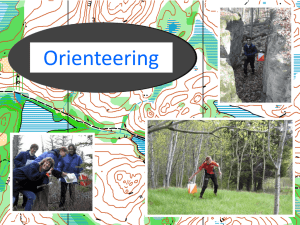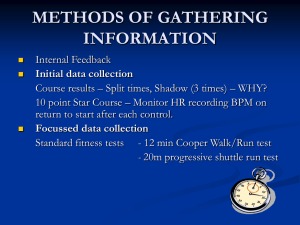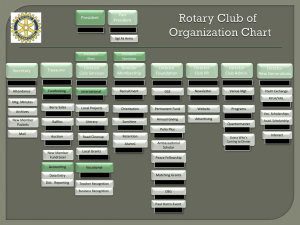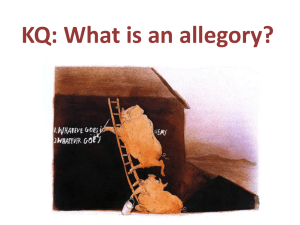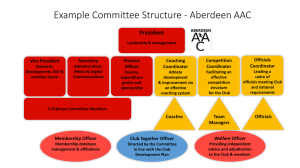Instructor`s PowerPoint - Canadian Orienteering Federation
advertisement
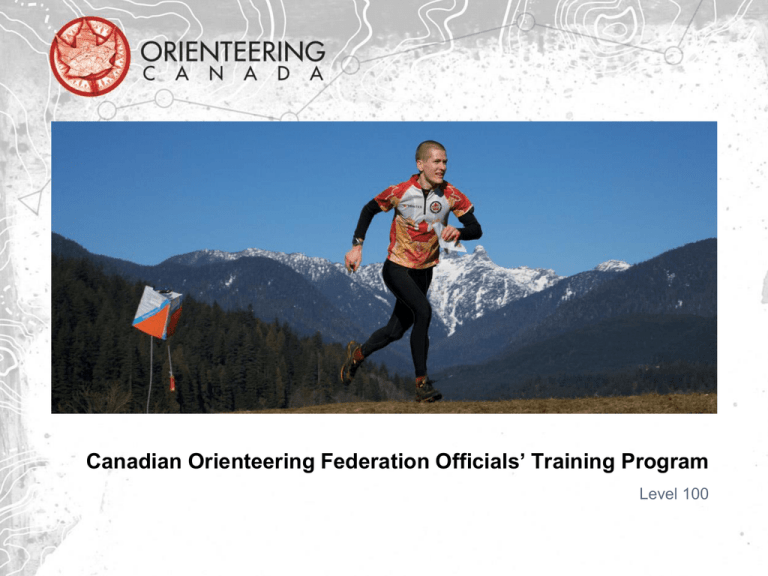
Canadian Orienteering Federation Officials’ Training Program Level 100 COF Credential Framework Certification Qualification Level 100 Organize and plan C events Level 200 Organize and plan B events. Control C events Organize and plan regional level Canada Cup events such as Western Canadian Orienteering Championships (WCOC). Control B events Organize and plan all events including Canadian Orienteering Championships (COC), North American Orienteering Championships (NAOC), World Ranking Events (WRE), World Orienteering Championships (WOC), World Masters Orienteering Championships (WMOC) etc. Control Canada Cup events to Regional level Level 300 Level 400 Level 500 Control all events. Act as a World Ranking Event Advisor 100 Level Requirements To be considered as a candidate for the 100 Level Officials’ course, the candidate must meet the following pre-requisites: • Participated in at least five C events • Participated in at least two Canada Cup or B events • Served as a volunteer at two events, Canada Cup, B or C To become a certified 100 level official, the candidate must complete the following requirements: • Attend all sessions of the 100 level course • Achieve a score ≥ 80% on the 100 level exam • Plan a beginner course and an intermediate course complying to C event standards • Act as an event director and course planner for a C event. Learning Objectives • • • • • Basic structure and objectives of the COF Long Term Athlete Development Plan (LTAD) Characteristics of Canada Cup, B, and C events Roles and responsibilities of event director, course planner, and controller Best practices for organizing a C event, including registration, simple starts, timing, and safety Basics of planning beginner, intermediate, and advanced courses for the Sprint, Middle, and Long formats Long Term Athlete Development Plan The Long Term Athlete Development model is an initiative by the COF to pursue the following goals: • Offer a sport which everyone can pursue at their desired level, recreational or competitive • Develop orienteering in a positive manner paying heed to the unique Canadian culture, landscape, and history while taking into consideration the changing international orienteering trends • Continually have better results at championship events at the Junior World Orienteering Championships (JWOC), World Orienteering Championships (WOC), and World Masters’ Orienteering Championships (WMOC) • Grow by attracting people of all ages to the sport LTAD Framework for Orienteering – 9 Stages ACTIVE START 0‐6 years String Course, Course 1 - majority of navigation by an adult • • • • • • • Learn fundamental movements and link them together into play Develop familiarity with maps, controls and punching systems Develop familiarity with the process of orienteering and prominent features used to navigate (trails, streams, large objects, boulders) Design activities that help children to feel competent and comfortable participating in a variety of fun and challenging sports and activities in differing terrain At upper age levels encourage trail walking/running and some off‐trail activities, such as jungle courses (string courses) or course 1 with a parent or coach Focus on skill development and participation; no competitive elements Participation awards only FUNdamentals 7‐9 years (String Course, Course 1 - some independent navigation) • • • • • • Activities and programs need to maintain a focus on fun, and formal competition should only be minimally introduced Learn to orient the map to north Learn to relate features on the map to the physical terrain in the forest Learn more extensive set of basic map features (trails, streams, fields, boulders, cliffs, buildings, fences) Develop proper running techniques on‐ and off‐trail by having youngsters follow a flagged route through somewhat dense forest, over and under fallen trees, over and under fences Learn safety rules of orienteering LEARN TO TRAIN 10 ‐ 12 years (Course 1 - independently or with shadow) • • • • • • • • • Practise feature familiarization and recognition, e.g., relate map symbols and colours to the terrain and vice‐versa Learn how to orient the map using linear terrain features Learn to recognize simple handrails in the terrain and how to navigate along them Think ahead; be aware of handrail changes along route Know how start, finish and controls are represented on the map Start learning international control description symbols Learn techniques that allow athletes to navigate off trails for short distances Learn basic route choice tactics and decision‐making principles, e.g. at every control, have a plan for getting to the next control Introduce rough orienteering. Focus on safe orienteering but occasionally point out where youngsters can safely run faster TRAIN TO TRAIN 1 13 ‐ 14 years (Course 2) • • • • • • Emphasize technical skill development, e.g. holding a bearing while running; map reading by thumb; orienteering with flow and control Practice following linear features (trails, fences, streams, fields) Learn to make use of features slightly off the handrails Learn to recognize less obvious handrails, e.g. a ridge system or a valley Practise simple route choice, e.g. cutting directly through the forest (off‐trail) for short distances, less than 100 meters, rather than taking a longer route following a handrail RJT (run, jump, throw): emphasize terrain running technique ‐ jumping; hopping on, off and over obstacles; running up, down and contouring across slopes; climbing over terrain barriers TRAIN TO TRAIN 2 15 ‐ 16 years (Course 3) • • • • • • • Practise contour interpretation; begin to distinguish up‐slopes from down in mapped land forms Navigate using rough map reading, i.e., concentrate on large contour features off‐trail Begin to identify contour features in the forest, e.g. small and large hills, highest points in the terrain Learn symbols for terrain runnability (colour code and special markings) Use rough compass technique to maintain direction through the forest towards obvious handrails less than 300 meters distant Choose reliable attack points Use precision compass to travel accurately from attack points to controls LEARN TO COMPETE 17‐18 years (Course 8 Female, Course 9 Male) • • • • • • • Practice holding elevation and taking controls when running across slopes Practice simplifying, enlarging, and extending the control Continue to practise contour interpretation and precision map reading Practise distance estimation; use pace counting for distances under 200 meters and practice intuitive estimation of longer distances Practice taking difficult controls in less detailed terrain with few catching features Manage inner dialogue while orienteering; visualize staying positive and focused; learn how to refocus thoughts after making mistakes or catching up with competitors Learn O‐CAD, if interested in mapping/course‐setting (learn how a course‐setter thinks) TRAIN TO COMPETE 19 ‐ 25 years (Course 9 Female, Course 10 Male) • • • • Continue to practice taking difficult controls in less detailed terrain with few catching features Move towards bold execution rather than always practicing safe, controlled, mistake‐free orienteering. Find out how fast it is possible to orienteer without continually making mistakes 19‐20 year olds are encouraged to race up into senior men/women categories in training to gain experience at the elite level Adjust speed according to the type of terrain and individual strengths TRAIN TO WIN 25+ years (Course 9 Female, Course 10 Male) • • • • • Make advance planning automatic. For each leg, decide on an execution plan and carry it out Maintain high level of proficiency in technical skills by continuously refining, improvising, and personalizing them Practise bold orienteering Display the highest possible level of consistency and control over complex decision making Provide positive role models to younger athletes ACTIVE FOR LIFE (All Courses) • • • • • 17 – 80+ years This stage can be entered at any age. Athletes who have completed the Learn to Train stage and want to remain active in the sport at a recreational level should be encouraged to continue as both athletes and officials. Adult beginners can be offered modified programs that take into consideration their specific cognitive, life skill, physical and technical abilities. Maintain life‐long physical activity and participation in sport Continue participating in orienteering competitions, in addition to becoming expert in other aspects of the sport, e.g. course setting, mapping, event organization, coaching Work/volunteer at the provincial or federal level to support orienteering and stay active in the orienteering family Compete at international age‐graded competitions, e.g. World Masters’ Orienteering Championships and other multi‐day events An Integrated Development System for Orienteering Officials are a part of a system that includes parents, athletes, clubs, coaches and Orienteering Canada. As officials, you are responsible to • Be educated • Have a thorough understanding of the LTAD principles for orienteering • Understand where and how officials fit in to the LTAD • Commit to supporting athletes in achieving their goals Characteristics of Canadian Orienteering Events • • • • In Canada, there are three levels of orienteering events: Canada Cup events B events C events Canada Cup Events • • • • • • Highest level orienteering events in Canada (national, regional, and provincial championships) Often multi-day events composed of races from all three disciplines of orienteering (Sprint, Middle, and Long) Attract participants from outside the local club. Generally include a banquet, accommodation for out-of-town orienteers, assigned start times, advance registration, and promotion to orienteering community and general public. Require several key officials (event director, course planner, controller, start chief, finish chief, registrar, etc.) and a large number of volunteers Ten courses for Long and Middle distance events and five courses for Sprint events B Events • • • • • Generally single day, weekend events held on forest maps within an hour or two of the local club’s city. Primarily attended by local club members Less formal than Canada Cup events. Ten-course Canada Cup format is usually compressed down to between three and five courses. Fewer volunteers than Canada Cup events. C Events • • • • • Least formal of the three levels of Canadian orienteering events Least amount of organization. Held over a couple of hours on a weekday evening or weekend morning. Most often held in an urban park for members of the local orienteering club. One to three courses and may use one of the standard point-to-point formats (Sprint, Middle, Long) or an alternative orienteering format, such as night-O, score-O, Memory-O, or Corridor-O. Why are C events important? • • • • • • Offer all orienteers opportunities for social and physical activity Provide opportunities to acquire and maintain orienteering skills on technically sound courses Recruit newcomers to orienteering Provide novice and junior orienteers non-intimidating learning experiences Provide novice officials with positive learning opportunities Clubs across Canada use a wide range of procedures and practices to run their C events. This 100 Level Officials’ Training Course aims to standardize the course planning and safety aspects of C events while allowing for regional flexibility in other aspects. Event Officials • • • • Orienteering events are typically organized by a team of three officials Event Director Course Planner Controller Event Official Roles as Defined by the COF Rules • • • 5.1.1 The event director shall take responsibility for the event. The event director shall appoint such further officials as are necessary and see that they understand and fulfill their duties. 5.1.2 The course planner shall design the courses and be responsible for preparing the control markers, punches, competition maps, control description lists and for the correct placing of the control markers and punches prior to the event. 5.1.3 The controller shall check the quality of the map and to recommend necessary revisions; Check the start and finish areas and all control locations for correct position and suitability; Check that the general standard of the course is in accordance with current rules and standards of course planning; Check that the course as planned is fair to all participants particularly with regard to the quality of map detail; Check that the terrain and course are safe for participants with respect to hazards and dangerous locations. C Event Orienteering Officials • • • For C events, the roles of the event director and course planner are often combined The role of a C event controller is to mentor the event director/course planner and review his/her courses. A C event controller must have at least 200 level certification. Officials and Volunteers Required for a C Event Position Number Required Qualifications Role Event Director/ Course Planner 1 COF O100 Level Official Plan courses, check control locations, arrange for map printing, place flags, and recruit necessary volunteers Controller 1 COF O200 Level Official Ensure courses are fair, safe, and comply with C event standards Registrar ~ 1 for every 100 participants expected None Collect fees and record names of participants Ensure membership status of all participants Start/Finish official (one person may perform both roles) ~ 1 for every 100 participants expected None Record starters Ensure appropriate interval between starts Record finishers Be aware of participants who did not report to the finish Beginner Clinics ~ 2 for every 100 participants expected Experienced orienteer Provide basic instruction in map reading and orienteering to beginners Volunteers • • • • • • • All orienteering clubs in Canada rely on volunteers to donate their time and share their expertise (orienteering and other skills) It is critical that all volunteers are treated with respect Assume that all volunteers are trying their best within their level of expertise and experience Recognize and acknowledge good work Emphasize volunteer contributions and their importance to the success of the event Remember that volunteers have personal and professional obligations that take precedence over their orienteering commitments Say thank-you Event Organization Scheduling Events • • • • C events are often scheduled on a standard day and at a standard time as a part of a weekly or monthly orienteering series. The date and location of C events is usually determined before the orienteering season by the local club’s executive or event coordinators. Event coordinators must consider the suitability of each map for the time of year when the event will be run; will the event be run at night? Will it be run in the snow? Will the vegetation be unpleasantly high? Will the area be filled with a large number of other users? Will the area be occupied by another organization’s event? Once the schedule has been arranged, the events coordinator will attempt to match a course planner and controller to each event based on the proximity of the maps to their work/home, availability, and level of experience. Permissions • • • • • Orienteering relies on the generosity of landowners to grant access to their property This includes both privately and publicly owned land, such as urban parks Some municipalities and area governing bodies do not require permission for events attended by a small number of participants It is the club’s responsibility to be aware of these permission thresholds and to seek event permission from the landowner when required Most clubs have a volunteer who makes any necessary permission applications Before the Event The Event Director/Course Planner (with the assistance of the controller) must ensure that all of the following tasks are completed well in advance of the event: Recruit event volunteers Plan and review course Obtain most recent version of the orienteering map Select orienteering format of the course Plan course Review course with controller and make any suggested changes Visit the control sites to confirm that all locations are properly represented on the map and safe for participants. Make any necessary changes Send course to controller for final review • • Promotion Update event information and meeting location on the club website Distribute event information and meeting location to the club e-mail list Promote event to non-orienteers using local club’s methods Equipment Obtain event equipment (flags, map bags, event box, registration sheets, event float, etc.) • Refreshments Prepare refreshments (cookies, juice, water, etc.) if provided • Print Maps Estimate the required number of maps. Print maps or arrange to have maps printed At the Event The event director/course setter should arrive at the event site with sufficient time to complete the following tasks before participants begin to arrive: • Place Flags Place all flags for the course Do not hide flags. They should be easy to find if a participant is in the correct location If the event area is in a high-traffic area, do not place the flags too early or they could go missing • Debrief Volunteers Ensure all volunteers are present and understand the tasks expected of them • Site Set-Up Place signs directing participants to parking and registration Set up registration. Ensure that the volunteers have enough waivers, membership forms, float, pens, etc. Set up start. Ensure that the start volunteer has a timing device, the maps (clearly separated by course), a clipboard for writing down start times, etc. Set up finish. Ensure that the finish volunteer has a timing device synched to the start watch and a clipboard for writing down finish times Set up refreshments if available Safety • • During the event, the event director/course setter is responsible for the safety of all participants. The event director will oversee the following safety measures: Bring the first aid kit and keep it in an easily accessible location Be aware of the best way to contact the local fire, ambulance, police, and search and rescue services Inform participants of potential hazards they may encounter during the event (busy roads, cyclists, slippery footing, unpleasant/dangerous flora and fauna, etc.) Encourage participants to wear reflective clothing at events with dark or low-visibility conditions Ensure that every participant is aware of the course closing time and that he/she must report to the finish even if he/she does not complete the course Keep a list (the start/finish list) of all participants out on course. Checkoff participants as they return. The event director shall not leave the event site until all participants have been accounted for Site Set Up Registration Beginners’ Clinics Course Parking Refreshments Start/Finish Last Control Registration Registration procedures vary between clubs. Common registration functions include • Greeting and directing new participants • Collecting event and membership fees • Collecting liability waivers • Collecting membership forms Beginner Clinic • • Most first-time orienteers require some instruction to successfully complete a course. An official should be available to give an overview to any newcomers. The beginner clinic instructor should focus on a few basic concepts: The essential map symbols How to orient the map to the terrain What the flags look like Start, punching, and finish procedures Basic safety procedures Reminder to check in at the finish Course closing time • After the event, be available to answer questions and review the course Start • The start official must complete the following tasks: Record the full name, start time, and course of each participant Confirm that participants have the correct map and control description Remind participants of the course closing time Leave a sufficient gap (usually at least one minute) between participants starting on the same course • Even if the start volunteer changes, the start location must remain the same. Finish • The finish official must complete the following tasks: Record finish time of each participant beside his/her name on the start list Calculate elapsed times during lulls in activity Invite participants to partake in refreshments Keep track of the number of participants still on course Timing • • • The timing at C meets is informal. For events using the SI system, participants’ times are calculated by the software. For events using pin-punches or an honour system, time is most often based on a wristwatch or stopwatch used by the start official/finish official. Refreshments and Post Event Social • Some clubs provide post-race refreshments to participants at C events. Others promote post-race social dining. Encouraging participants to socialize after events, and allowing them opportunities to do so, helps to create relationships, foster a sense of community, and persuade newcomers to continue in the sport. Overdue Participants • 1. 2. 3. 4. At course closing time, check the finish list to see if any participants are missing. If a participant has not returned, follow the procedure below: Check the start list to determine if the participant actually started and his/her start time. Determine how long the participant has been on the course Ask other participants if they have seen the missing person either on the course or at the finish. The person may have returned and not checked in to the finish Determine the location where the person was last seen. Was it early in the course or late? Did he/she appear to be lost/in trouble? What was he/she wearing? Did he/she have any food or drink? Search parking areas, washrooms, and other nearby facilities. Is the person’s car still in the parking lot? Are the person’s belongings at the staging area? Are there friends or family waiting at the finish? 5. Check the membership form or ask around for the person’s cell number. Call the phone. 6. Arrange for control pick-up volunteers to keep an eye out for the overdue participant. At least one volunteer must remain at the finish at all times in case the participant returns. 7. If the event is using SI and the SI number of the participant is known, the control units can be downloaded to confirm the time of each punch 8. Send an experienced orienteer with a cell phone to run the course backwards. If there are several experienced volunteers available send them to run the course forwards, to check all major trails and roads, and to drive or run the perimeter of the map especially the area of a safety bearing. All search volunteers must have a cell phone and be experienced, competent orienteers who are unlikely to become lost themselves 9. At some point no later than 3 hours past the overdue person’s maximum allowed time, the event director must contact emergency services and ask for assistance. The decision to call in emergency services should be made by the event director and the controller and will depend upon circumstances Examples of factors to be considered include: • Age, health, experience of the participant • Weather conditions • Length of time the participant is overdue • Last known location of participant • Amount of daylight left • Nature of the terrain • The Emergency Services will become the search master upon arrival at the site. Event Clean Up All event flags, flagging, equipment, signage, and garbage must be collected and sorted at the end of each event Begin collecting control flags once all competitors have returned, the course-closing time has elapsed, or sufficient time has passed since the departure of the last starter that the first controls on the course are no longer in use. Instruct control collectors to remove any remaining flagging tape used to pre-mark control sites Sort event equipment and either return it to the club’s equipment storage or pass it along to the officials of the next event. Take care to keep the equipment neat and organized so that future event officials will be able to find what they need quickly Remember to collect direction signs or flags that are placed away from the primary event site Collect and dispose of any garbage at the event site so that the site is left as clean or cleaner than it was before the event Posting Results • • Calculate and post the event results on the club website or email list as soon after the event as possible Posting results can bring traffic to the club website, help keep track of event participation numbers, and allow club members to track their improvement over time Budget and Finance • • • • Orienteering clubs across Canada and their provincial/territorial orienteering associations (P/TOA) are registered as non-profit organizations and societies. They are accountable to the government and to their members for accurate budget keeping and prudent management of the club’s assets and resources Event directors should be aware of the budgetary procedures of their local club. They should submit any receipts for expenses, event monies, and necessary paperwork to the club treasurer as soon after their event as possible Course Planning Course Planning Terminology Control • • • A three-sided orange and white flag that identifies the checkpoint location in the terrain. Control locations are indicated on the map with red circles The flag should be placed in the centre of the control circle Leg • The section of course between two controls Point Feature • • A small feature that does not extend over a large area. Knolls, cup depressions, pits and boulders are all examples of point features • Identify the point features in the map snippet below Linear Feature • • • An elongated feature, such as a fence, stream, or ridge, that continues in a constant direction for more than a couple metres A linear feature may be used as a catching feature or a handrail Identify the linear features in the map snippet below Dot Knoll • • A hill too small to be represented by a contour line Shown on the map as a brown dot Re-entrant • • • A contour feature, usually located on a slope, that resembles a rising, dead end valley A re-entrant is formed when a contour line re-enters a hill Re-entrants can be small or large Spur • • A promontory of land jutting out from a hillside The ground slopes downward from a spur Handrail • • • A linear feature parallel to an orienteer’s direction of travel Orienteers may follow handrails to simplify their navigation and increase their speed Discuss the handrails in the map snippet below Attack Point • • • • A large, obvious feature near the control that is easier to locate than the control feature Participants may rough orienteer to the attack point and then precision orienteer to the flag The careful orienteering between the control and the attack point is known as attacking the control Discuss the attack points in the snippets below Catching Feature • • • A distinct, linear terrain feature behind a control A catching feature catches or alerts orienteers that they have travelled past the control Discuss the catching features in the map snippet below Bingo Control • • A control placed on a small point feature located in an otherwise featureless area Bingo controls are found by luck rather than technique and skill Characteristics of Beginner, Intermediate, and Advanced Orienteering Courses • • Beginner Beginner orienteering courses, especially those designed for children, should be planned to maximize the enjoyment and success of the participants. The course should be short, follow distinct handrails, and have no route choice. Each decision point should be marked with a control, placed to lead participants in the correct direction. • • Intermediate Intermediate orienteering courses introduce route choice and offtrail control locations. Technical, cross-country routes should be short, have strong attack points and/or catching features, and make use of contours and vegetation as handrails. • • Advanced Advanced orienteering courses should challenge participants with complex route choices requiring careful navigation, and subtle control site placement necessitating precision map interpretation. The course should be designed to test contour reading, compass, and route planning skills. Course Planning Theory • • • • Try to plan courses that are enjoyable, challenging, and fair for all participants Course planning is not a competition between the planner and the participant It is not the course planner’s job to trick or fool participants or to send them into unpleasant or unsafe terrain Set courses that reward skill and technique Terrain • • • • A well planned orienteering course uses the best terrain in an area Terrain that includes a rich trail network, intricate contours, many manufactured or natural features, and/or a variety of vegetation can provide interesting orienteering Terrain that has few details, thick vegetation, or is extremely steep is not desirable On advanced courses some climb is acceptable The Map • • • The quality of orienteering maps varies greatly Use areas of the map and control sites that have been mapped accurately Areas that have changed significantly since mapping or were never properly mapped should be avoided if possible Control Features • • • • • • • • Create interesting legs not interesting controls Controls are the checkpoints that end one leg and begin another Sites should be chosen based on possible routes rather than for specific features Controls must be placed on clearly defined, accurately mapped features Control sites must be recognizable both on the map and in the terrain Avoid placing controls in dense or bland areas (bingo controls) Avoid placing controls in out-of-bounds and dangerous areas Do not hide control markers. Place them so that they are fair and visible to all participants in the correct location Control 1 is in the middle of the wall. Wall corner or wall/path junction are more concrete control locations Control 2 is in the centre of a field. There is no feature to place the flag on Control 3 is on the end of a fence. This is an acceptable control location Course Legs • • • • • An orienteering course is made up of a series of legs. Plan legs that vary in length and direction. The course should be made up of technical, medium legs and quick, short legs, as well as, a couple of long, route-choice legs. Each leg should change the participant’s primary direction of travel. A successful orienteering leg leads the participant through interesting, technical terrain, emphasizes map reading problems, offers route choice, and allows for both rough and precision orienteering Route Choice • • • Route choice can be created by planning legs that force the participant to travel across, rather than along, features in the terrain. Not all legs have to have perfect route choice. Short legs can be used to transport participants to the beginning of a route choice leg or to take advantage of an intricate area. If the planned course sends participants through an area multiple times, have them approach, pass through, and leave the area at varying angles to keep it from getting stale. Route Choice Common Planning Errors Dog legs • • • • • A dogleg occurs when the best route forces the participant to travel back over terrain that he/or she just covered Doglegs are undesirable because they can be frustrating or boring for the participants and may unfairly give away the location of a control Legs that form and acute angle with the previous leg are often dog legs To avoid doglegs, plan courses with angles greater than of 90 degrees. A dog leg can also be created when a control is placed in a dead end Dog legs can often be fixed by adding an extra control Dog Legs Unpleasant/Unsafe Control Sites • • Controls should not be placed in difficult or unpleasant to access locations. Dangerous locations, such as the top of cliffs, should also be avoided Bingo Controls • • • Bingo controls are controls that are found by luck rather than skill. They are placed on point features in bland or under-mapped terrain with low visibility. Participants may pass within a few metres of the control and not find it while others may stumble upon it. Encouraging Cheating • • • • Especially on sprint maps, there are symbols that represent out-ofbounds or uncrossable features Uncrossable features, such as high walls and fences, may be difficult to cross in the terrain for some but not for others Some uncrossable features, such as those marked as out-of-bounds, may appear as easily-crossable flower beds in the terrain Avoid setting legs in which an advantage is gained by participants who disobey the rules Point to Point Course • • • • A point-to-point course is a traditional orienteering course. To complete the course, participants must visit the control points in the designated order. There are many variations, which can be incorporated into a point-topoint course including control picking, butterflies, and long legs. Sprint, middle, and long distance point-to-point courses, along with relay, are the disciplines raced at the Canadian Orienteering Championships (COC) and World Orienteering Championships (WOC) Sprint • • • • • • Expected winning time: 12-15 minutes Scale: 1:4000 or 1:5000 Contour interval: 2m or 2.5m Sprint maps have a modified symbol set (ISSOM), A short, fast, intense race that is run through complicated urban terrain or intricate forest Sprint course planning is characterized by short legs, changes of direction, and complicated route choice through technical terrain Middle • • • • • • Expected winning time: 30-35 minutes Scale: 1:10000 Contour interval: 2.5m or 5m Maps use standard symbol set (ISSOM) Middle distance courses lead participants through technical forested terrain A middle distance course should reward precision orienteering Long • • • • • • Expected winning time: 75-90 minutes Scale: 1:15000 for elite, 1:10000 for other participants if possible Contour interval: 2.5m or 5m Maps use standard symbol set (ISSOM) Long distance courses focus on route choice and physical endurance A long distance course should have at least one route choice leg over a kilometre long Score-O • • • • • • Control points are scattered across the map. These controls may be visited in any order. Participants are given a pre-determined time limit and mass start. The goal is to find as many controls as possible within the time limit. Participants who return after the deadline may incur a penalty. In some score-o events controls may have different point values depending on their difficulty and distance from the start Course Planning Step by Step • • • • • • • • • • • Step 1 - Choose the map Step 2 - Choose the type of course to plan Step 3 - Choose Start/Finish/parking locations Step 4 - Plan beginner course first Step 5 - Plan other courses Tip: Start planning courses by looking for a few long, interesting, route choice legs and plan the course around them. Step 6 - Consult with controller Step 7 - Revise Step 8 - Make a site visit to check the map and control locations Step 9 - Revise Course Planning Software • • • • • • • There are three computer programs that can be used to plan basic orienteering courses: Purple Pen – http://purplepen.golde.org/ Purplepen software is freeware and does not require license information. The program is intuitive and performs the basic course planning functions needed for C event courses well. Condes – http://www.condes.net/ Condes is the most sophisticated course planning software. Course planners must get the licensing information from their club. OCAD – www.ocad.com OCAD is an orienteering mapping software that has course planning capabilities. Many first time users find the course setting application to be clunky and difficult to understand. Course planners must get the licensing information from their club. A trial version of OCAD is available for download on the OCAD website
